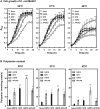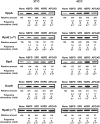Effect of Spermidine Analogues on Cell Growth of Escherichia coli Polyamine Requiring Mutant MA261
- PMID: 27434546
- PMCID: PMC4951125
- DOI: 10.1371/journal.pone.0159494
Effect of Spermidine Analogues on Cell Growth of Escherichia coli Polyamine Requiring Mutant MA261
Abstract
The effects of spermidine analogues [norspermidine (NSPD, 33), spermidine (SPD, 34), homospermidine (HSPD, 44) and aminopropylcadaverine (APCAD, 35)] on cell growth were studied using Escherichia coli polyamine-requiring mutant MA261. Cell growth was compared at 32°C, 37°C, and 42°C. All four analogues were taken up mainly by the PotABCD spermidine-preferential uptake system. The degree of stimulation of cell growth at 32°C and 37°C was NSPD ≥ SPD ≥ HSPD > APCAD, and SPD ≥ HSPD ≥ NSPD > APCAD, respectively. However, at 42°C, it was HSPD » SPD > NSPD > APCAD. One reason for this is HSPD was taken up effectively compared with other triamines. In addition, since natural polyamines (triamines and teteraamines) interact mainly with RNA, and the structure of RNA is more flexible at higher temperatures, HSPD probably stabilized RNA more tightly at 42°C. We have thus far found that 20 kinds of protein syntheses are stimulated by polyamines at the translational level. Among them, synthesis of OppA, RpoE and StpA was more strongly stimulated by HSPD at 42°C than at 37°C. Stabilization of the initiation region of oppA and rpoE mRNA was tighter by HSPD at 42°C than 37°C determined by circular dichroism (CD). The degree of polyamine stimulation of OppA, RpoE and StpA synthesis by NSPD, SPD and APCAD was smaller than that by HSPD at 42°C. Thus, the degree of stimulation of cell growth by spermidine analogues at the different temperatures is dependent on the stimulation of protein synthesis by some components of the polyamine modulon.
Conflict of interest statement
Figures






Similar articles
-
Enhancement of the synthesis of RpoE and StpA by polyamines at the level of translation in escherichia coli under heat shock conditions.J Bacteriol. 2009 Sep;191(17):5348-57. doi: 10.1128/JB.00387-09. Epub 2009 Jun 19. J Bacteriol. 2009. PMID: 19542278 Free PMC article.
-
Formation of a compensatory polyamine by Escherichia coli polyamine-requiring mutants during growth in the absence of polyamines.J Bacteriol. 1986 Apr;166(1):128-34. doi: 10.1128/jb.166.1.128-134.1986. J Bacteriol. 1986. PMID: 3514574 Free PMC article.
-
Effects of various triamines on cell-free polypeptide synthesis of Escherichia coli and on growth of its polyamine auxotrophs.Chem Pharm Bull (Tokyo). 1990 Jun;38(6):1648-52. doi: 10.1248/cpb.38.1648. Chem Pharm Bull (Tokyo). 1990. PMID: 2208375
-
Effects of polyamines on protein synthesis and growth of Escherichia coli.J Biol Chem. 2018 Nov 30;293(48):18702-18709. doi: 10.1074/jbc.TM118.003465. Epub 2018 Aug 14. J Biol Chem. 2018. PMID: 30108177 Free PMC article. Review.
-
Polyamine Modulon in Escherichia coli: genes involved in the stimulation of cell growth by polyamines.J Biochem. 2006 Jan;139(1):11-6. doi: 10.1093/jb/mvj020. J Biochem. 2006. PMID: 16428314 Review.
Cited by
-
Investigation of the polyamine biosynthetic and transport capability of Streptococcus agalactiae: the non-essential PotABCD transporter.Microbiology (Reading). 2021 Dec;167(12):001124. doi: 10.1099/mic.0.001124. Microbiology (Reading). 2021. PMID: 34910617 Free PMC article.
-
Cytoprotective Activity of Polyamines Is Associated with the Alternative Splicing of RAD51A Pre-mRNA in Normal Human CD4+ T Lymphocytes.Int J Mol Sci. 2022 Feb 7;23(3):1863. doi: 10.3390/ijms23031863. Int J Mol Sci. 2022. PMID: 35163785 Free PMC article.
-
Polyamine function in archaea and bacteria.J Biol Chem. 2018 Nov 30;293(48):18693-18701. doi: 10.1074/jbc.TM118.005670. Epub 2018 Sep 25. J Biol Chem. 2018. PMID: 30254075 Free PMC article. Review.
-
Cytotoxic Mechanism of Excess Polyamines Functions through Translational Repression of Specific Proteins Encoded by Polyamine Modulon.Int J Mol Sci. 2020 Mar 31;21(7):2406. doi: 10.3390/ijms21072406. Int J Mol Sci. 2020. PMID: 32244348 Free PMC article.
-
Caldomycin, a new guanidopolyamine produced by a novel agmatine homocoupling enzyme involved in homospermidine biosynthesis.Sci Rep. 2024 Mar 30;14(1):7566. doi: 10.1038/s41598-024-58296-0. Sci Rep. 2024. PMID: 38555406 Free PMC article.
References
-
- Watanabe S, Kusama-Eguchi K, Kobayashi H, Igarashi K. Estimation of polyamine binding to macromolecules and ATP in bovine lymphocytes and rat liver. J Biol Chem. 1991; 266(31): 20803–9. - PubMed
MeSH terms
Substances
LinkOut - more resources
Full Text Sources
Other Literature Sources
Molecular Biology Databases

